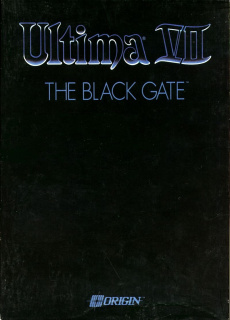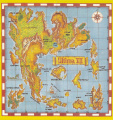Ultima VII: The Black Gate
| Ultima VII: The Black Gate | ||||||||||||||||
|
MS-DOS - USA - 1st edition. |
||||||||||||||||
|
Ultima VII: The Black Gate is a fantasy role-playing video game developed and published by Origin Systems for MS-DOS on 1992-04-16. The game is the seventh title in the Ultima main series and showcases a radical new game engine.
In the game, you play a character known as The Avatar, a person who occasionally travels from Earth to the Renaissance-era fantasy land of Britannia to help save the land from various evil denizens. The current threat comes from a strange entity known as the Guardian who has created an insidious cult that is taking over the land.
An SNES port of Ultima VII was made, but it's so different from the DOS release that it is effectively a new game.
Contents
Personal
| Own? | Yes. Four copies. Box with 5.25" diskettes with manual. Missing Fellowship medallion. Complete Ultima VII CD-ROM. Two MS-DOS copies published in the Complete Ultima CD-ROM compilation. I also own The Key to the Black Gate hint book. |
|---|---|
| Won? | Yes. |
| Finished | October 2004. |
I first saw Ultima VII at my friend Kevin's house not too long after the game was released. Until this point, the only other Ultima title I had played was Ultima: Exodus, so I was completely blown away by the game. I remember us deleting the game from his computer to free up memory for other games, and then being completely unable to get the game to load when we reinstalled it later due to the very specific memory requirements. Thankfully, a family friend of his made us a boot disk which got the game running again. We played the game a lot, but never got that far in the game. I borrowed the game from him for a while and got it to work on my computer, but ended up filling up my hard drive because the game took so much space and had such large save-game files. Because it had such a big impact on me, I ended up buying the game from him after he got tired of it, and I still have the original box and disks. He also bought Ultima VII, Part II: Serpent Isle which we played and enjoyed, but never beat either. I continued to come back to Ultima VII off-and-on over the years. I also bought a CD-ROM collection of The Complete Ultima VII which included both parts and both expansions. In the late 1990s, once Windows became the primary OS for PCs, it became extremely difficult to get the game to run and I rarely played it. In the 2000s, someone created a memory manager for Ultima which allowed it to run natively in Windows, which re-piqued my interest in the game. However, it wasn't until the Exult project (an attempt to re-create the Ultima VII engine from scratch) became stable that I hunkered down and played the game completely from beginning to end.
Review
| 8 | 10 | 10 | 10 | 10 |
Best Version: MS-DOS
— This section contains spoilers! —
Good
- The game engine is quite revolutionary for the time. It is incredibly immersive with a lot of sandbox elements that let you live in the world, rather than just walk through it. You can take a sack of flour, open it, place flour on a counter, add water to the flour to make dough, place the dough on a burning hearth and bake bread, and finally eat the bread. Many other objects are equally as detailed. NPCs actually act like people, waking in their beds in the morning, traveling to their jobs, working about in their shop, eating meals, and then returning to their homes at night.
- Ultima VII has an engaging story revolving around ritualistic murders, a suspicious religion, and a dastardly plot to overthrow the government and assassinate the king. It really shows how dangerous religions can be when they're made up of blind-faith believers and the person at the top has ill intentions.
- The mouse-driven interface and inventory system really makes the game run smoothly, and was ahead of its time in the industry. I especially like the paper doll player interface.
- The game has gorgeous graphics for the time; the pixel art is top notch. It also makes good use of palette shifting for ambiance and animation and pseudo-transparency.
- The soundtrack is vast featuring over 50 tracks of music. It also has a lot of sound effects, environmental ambiance, and a fair amount of speech.
- There are dozens of side-quests to solve, secrets to uncover, and Easter eggs to find. Every time you play the game you'll discover something new.
- The game has a massive amount of dialogue. Every character in the game will talk your ear off about all sorts of topics if you let them. By the end of the game, you will have read the equivalent of an entire novel. There is also a really impressive feature where, if specific NPCs are in the area during a conversation, they will join in. Hundreds of characters have unique portraits as well. All of this adds a lot of verisimilitude.
- The game has fantastic packaging. The manual is written as though it were an actual book in the game world and is very interesting, the map is cloth and written using in-game runes, it even comes with a shiny Fellowship medallion seen in the game.
- Although many players have criticized the combat system because you can't control each party member directly like in the previous Ultima games. While this is quite a shift, I think that only being able to give your party general commands fits the game's theme perfectly. They are meant to be actual humans with minds of their own.
- The Fellowship is well designed, functioning very much like a religious cult. New recruits are suckered into it, thinking it's a helpful enterprise, but as they get deeper involved, they become ensnared and devote their lives to it and work to recruit others. It has tons of money, yet most of their members remain poor, and it actively fights against progress.
- The hero can be a woman.
- It's minor, but, I like how the game's copyright protection is performed in-universe.
Bad
- One of the problems with the massive amount of dialogue is knowing what is useful. You can spend hours reading about stuff that doesn't pertain to the main goal.
- Likewise, with all the side-quests, you often find yourself spending hours on them only to discover they have nothing to do with the main quest of the game.
- The transportation system, though quite visionary, is poorly implemented. Ships and carts are difficult to operate, and the relatively small size of the map makes the cart unnecessary. Also, once you learn just how easy it is to get the vastly superior magic carpet, the others are totally worthless.
- The game tries to prevent the player from stealing by implementing a system that protects against it, but it's easily circumvented, and sometimes backfires.
Ugly
- Even at the time, it was very difficult to get the game to run properly because Origin created their own memory manager. This meant, even if you had a top-of-the-line computer, you most likely still had to use a boot disk, which was pretty much unheard of for other video games of the time. However, this also mad the game extremely difficult to run on a system with Windows 95. Also, the instructions for setting up a boot disk were pretty archaic, so, unless you had a fairly good understanding of the inner-workings of DOS, you'd have a hard time getting the game to run.
- There were several game-breaking bugs. If you didn't have enough disk space to store a save game, instead of getting an error, large sections of the game map to become a void. Another can be accidentally triggered by flying over the Isle of the Avatar on the magic carpet.
- Although the game world is highly open right from the get-go, this often backfires. Major plot points can be skipped, quests can be completed out of sequence, and lots of story elements can be spoiled because of this. For example, you can reach the hideout of one of the main villains pretty early in the game, and there will be evidence of several murders which have yet to take place. The designers should have either have come up with ways to prevent this from happening, or adjusted the in-game dialogue to account for it.
Media
Box Art
This is the original box which was used for all regions with minor changes to the layout. I originally thought the box was really dull, and that the designers should have made actual art. Later, I can now appreciate that they were trying something unique, but I still think it's a bit of a cop-out and would have much rather seen something like the art on the cover of the clue book.
Documentation
Fellowship (Manual).
Maps
These maps are 24,576 x 24,576 pixels; too big to be handled properly by the web site. You'll have to download them to see them.
Screenshots
Fan Art
Denis Loubet's alternate cover, 2016.
Videos
Play Online
Representation
| Strong female character? | Pass | You can play as a female avatar and, there are three strong female party members like Jaana, Julia, and Katrina. Lots of other female NPCs in the game as well. |
|---|---|---|
| Bechdel test? | Pass | When playing as a female, this passes easily. There are also instances where female NPCs speak to each other. |
| Strong person of color character? | Fail | Although there are a number of NPCs who are persons of color (Danag, Glenno, Margareta, Martine, Martingo, Penumbra, Sasha, Sir Jordan, etc.), none are that important. |
| Queer character? | Pass | The brothel workers, Roberto, Martine, and Wench, will all have have sex with the Avatar even if you're the same gender. |
Links
- wiki.ultimacodex.com/wiki/Ultima_VII:_The_Black_Gate - Ultima Codex.
- filfre.net/2019/03/scientology-and-the-fellowship - How the Fellowship is based on cults like Scientology.
- Video Games
- 1992 Video Games
- Video games developed by Origin Systems
- Video games published by Origin Systems
- DOS Games
- Video Game Genre - Exploration
- Video Game Genre - Role-playing game
- Media Theme - Adventure
- Media Theme - Fantasy
- Media Theme - Mystery
- Media Theme - Religious Fiction
- Software Distribution Model - Commercial
- Video Games I Own
- Video Games I've Beaten
- Video Game Rating - 8
- Video Game Graphics Rating - 10
- Video Game Sound Rating - 10
- Video games which can be played online
- Video games with a strong female character
- Video games that pass the Bechdel test
- Video games without a strong person of color character
- Video games with a queer character
- Video Game Prime Order - Adventure, Strategy, Action
- Game Mechanic - Playable Female Character
- Game Mechanic - Sandbox
- Game Mechanic - Unwinnable State
- Trope - Damsel In Distress
- Favorite
- Favorite Games

















